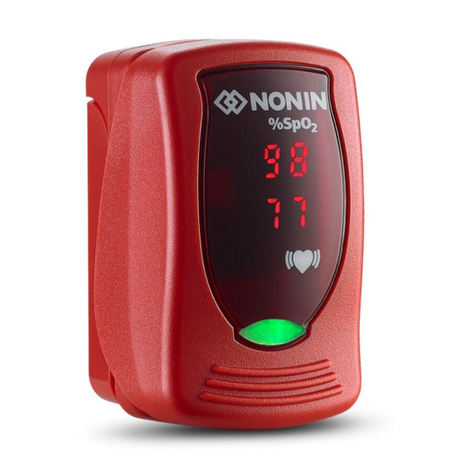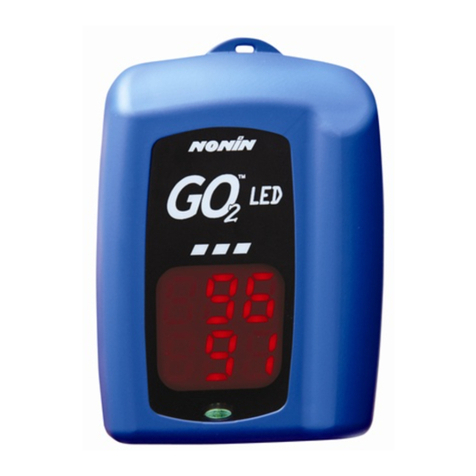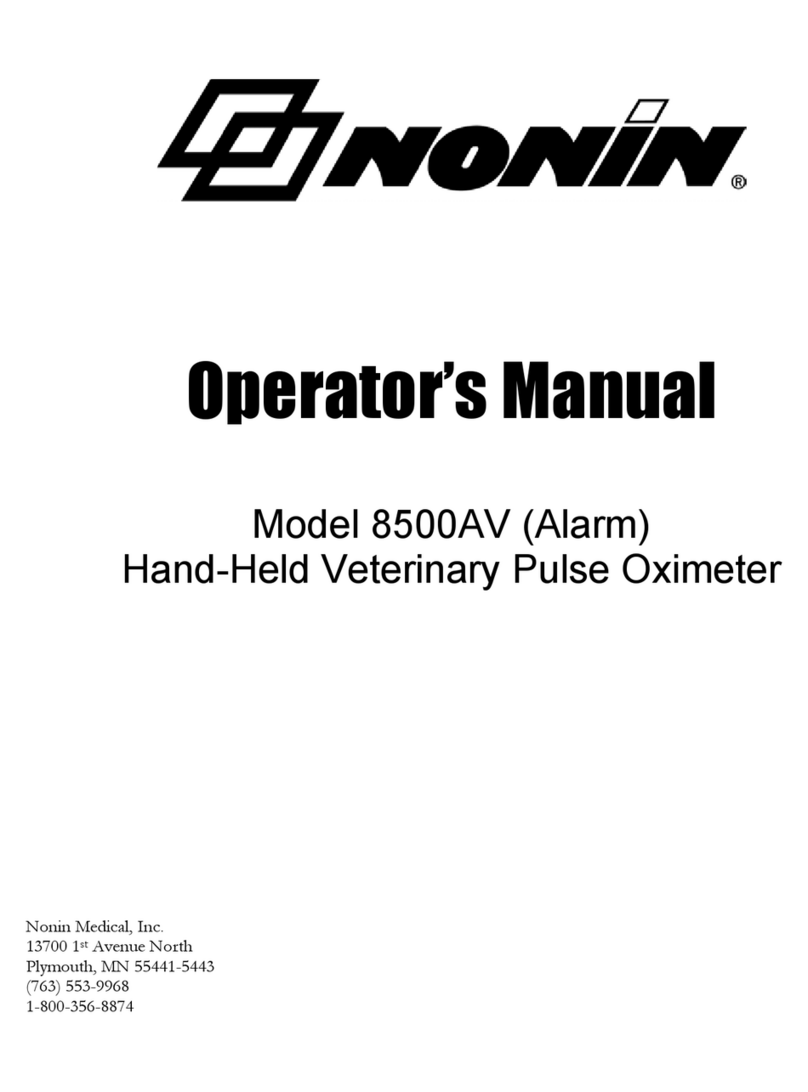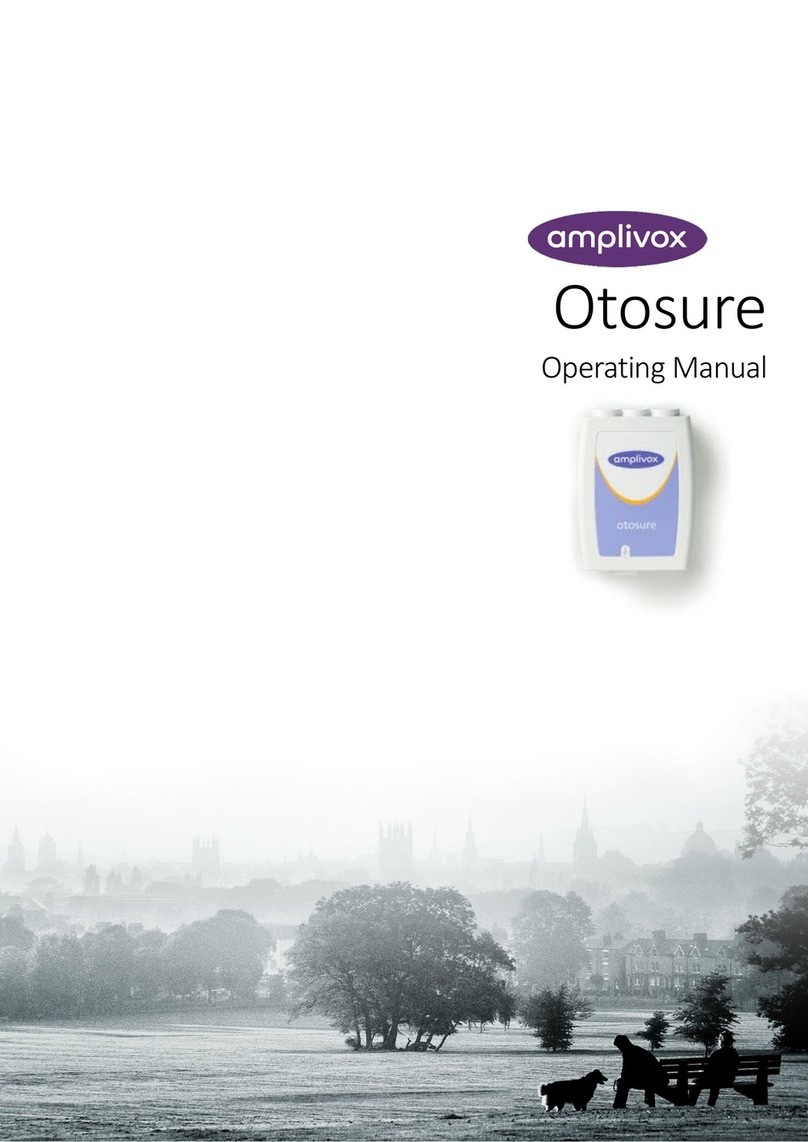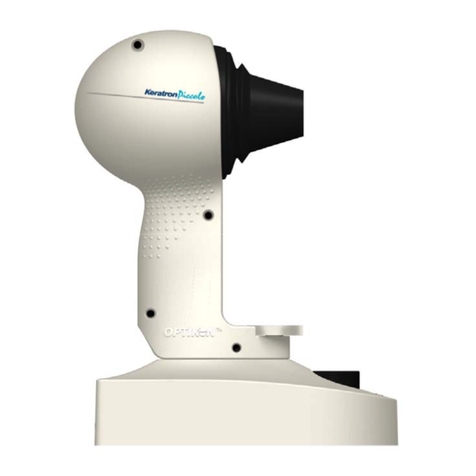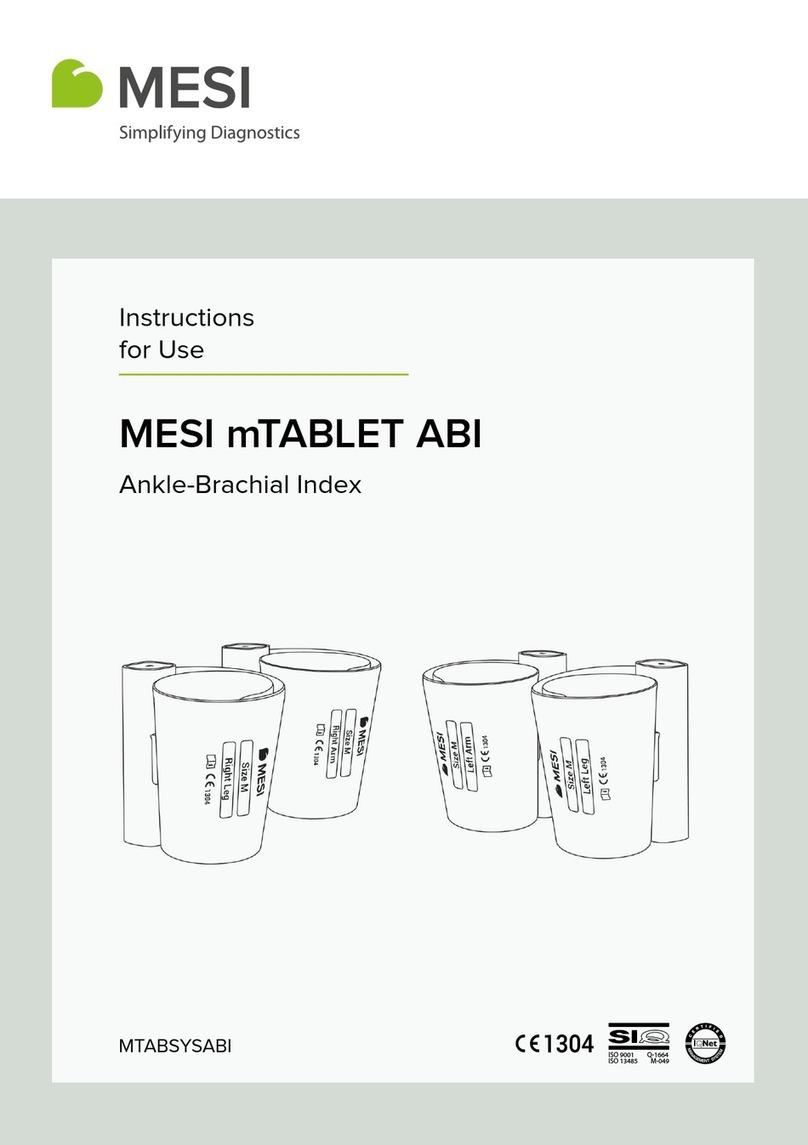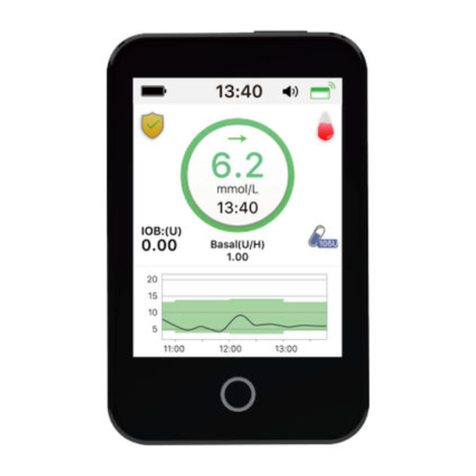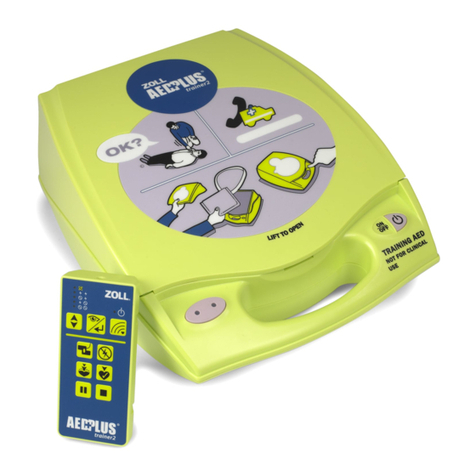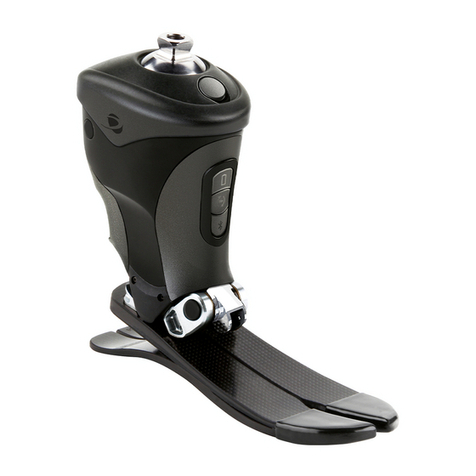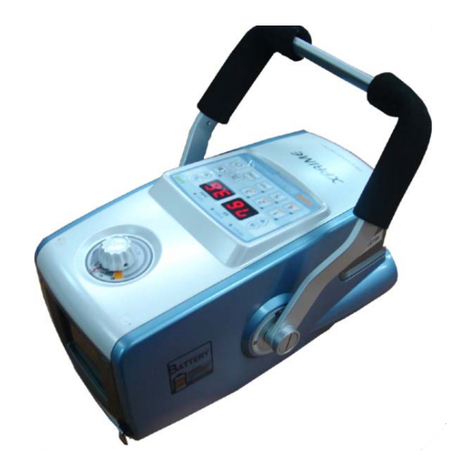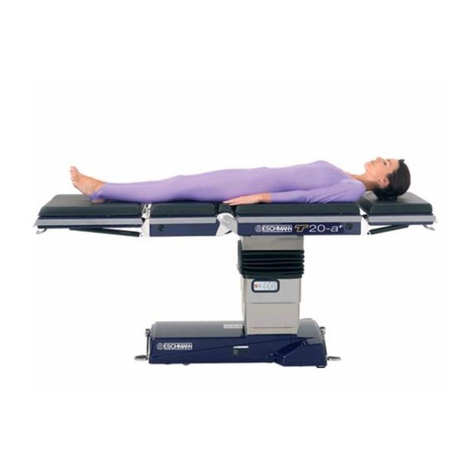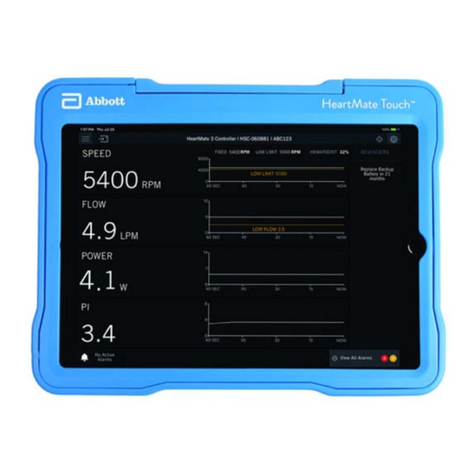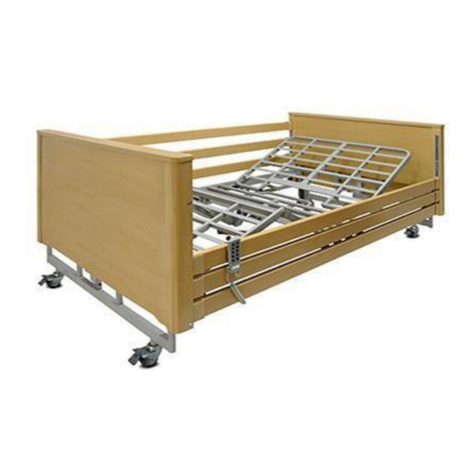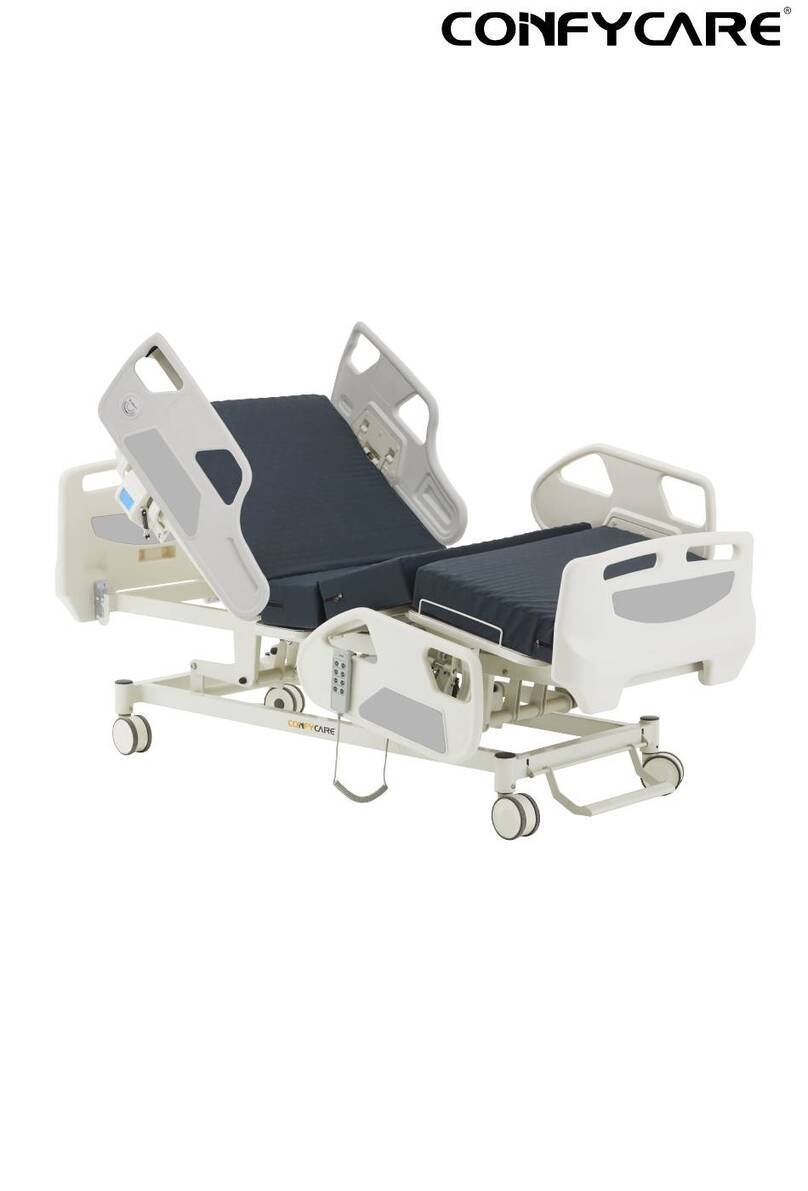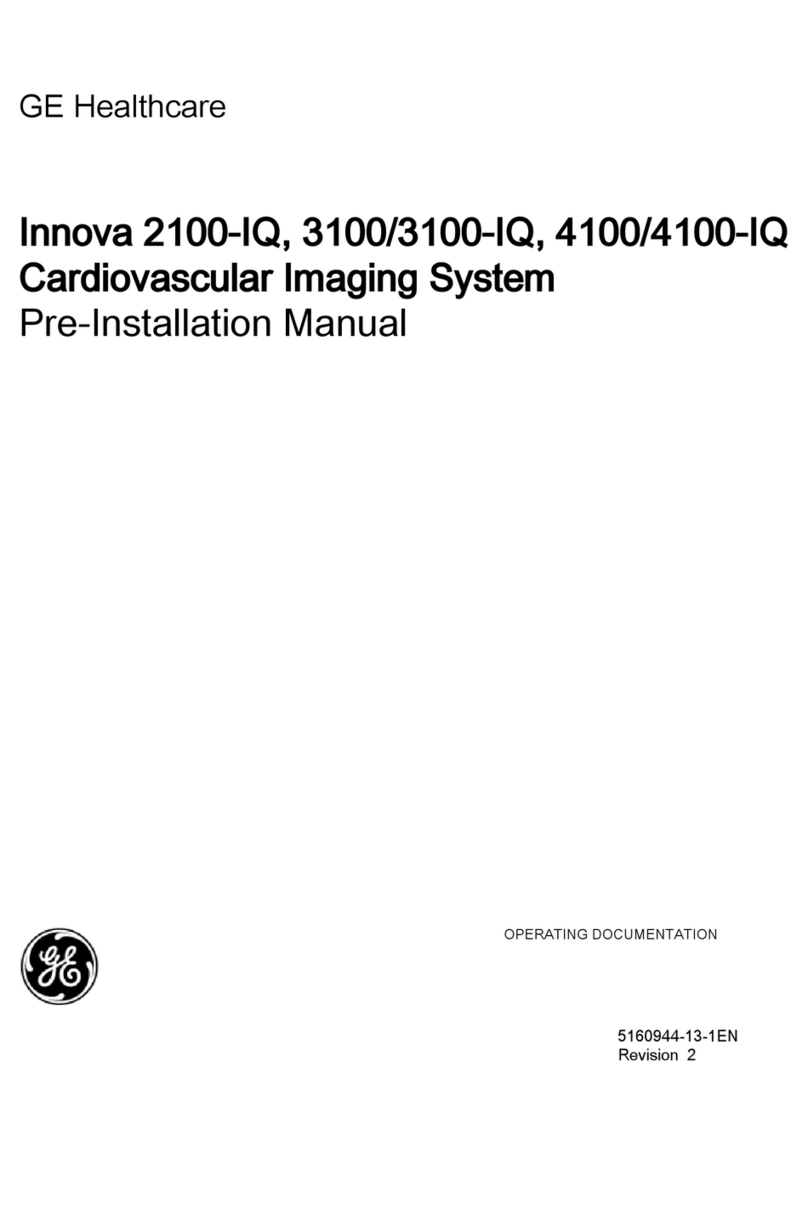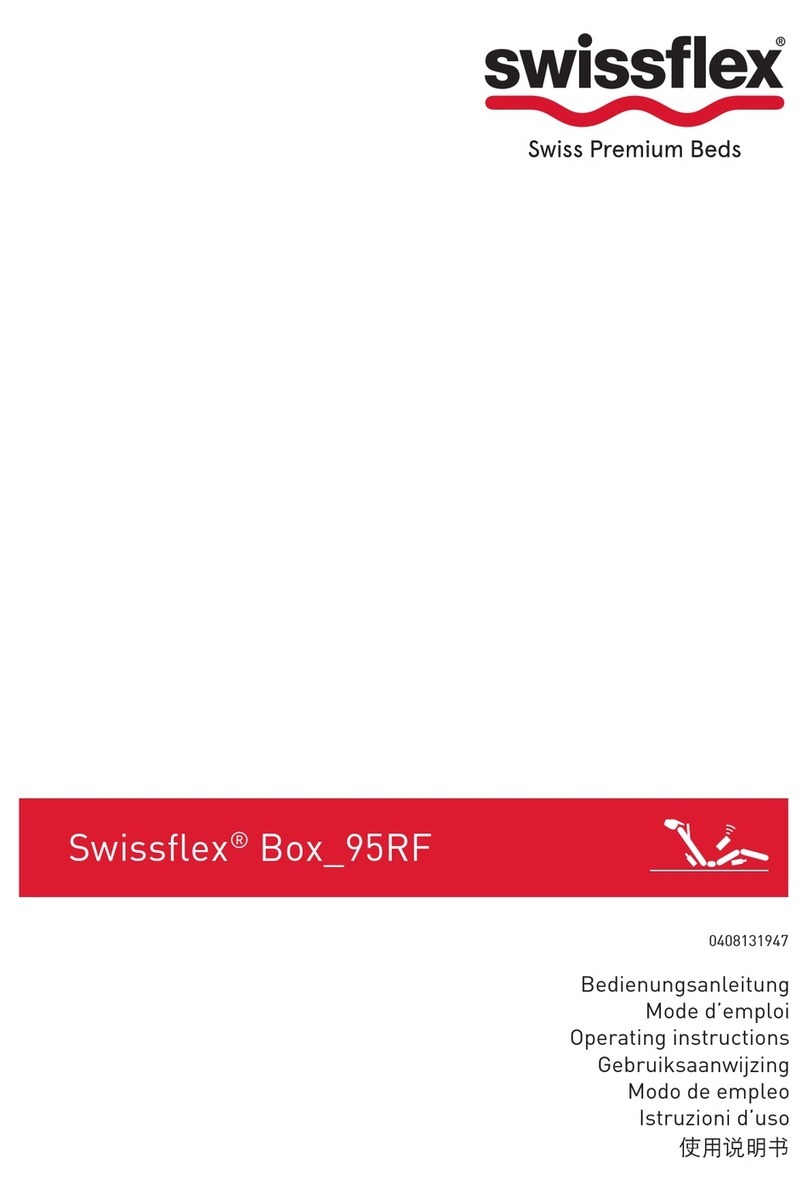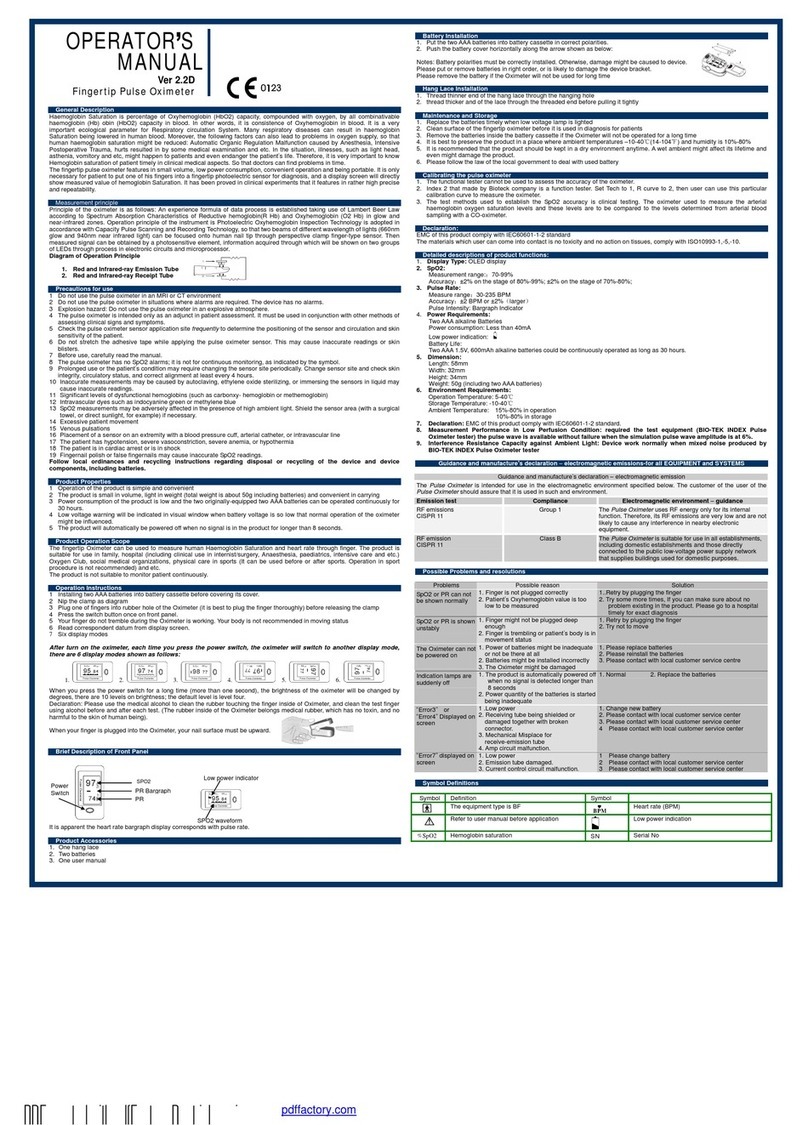Nonin 9843 User manual

Operator’s Manual
Model 9843
Pulse Oximeter and
Carbon Dioxide Detector
0123
English

Caution: Federal law (USA) restricts this device to sale by or on
the order of a physician.
Caution: Read this manual carefully before using the Model 9843.
The information in this manual has been carefully checked and is believed
to be accurate. In the interest of continued product development,
NONIN reserves the right to make changes and improvements to this
manual and the products it describes at any time, without notice or
obligation.
Nonin Medical, Inc.
13700 1st Avenue North
Plymouth, MN 55441-5443
USA
(763) 553-9968
(800) 356-8874 (USA and Canada)
Fax (763) 553-7807
www.nonin.com
References to “NONIN” in this manual shall imply Nonin Medical, Inc.
Nonin is a registered trademarks of Nonin Medical, Inc.
©2005 Nonin Medical, Inc.
Authorized EC Representative:
MPS, Medical Product Service GmbH
Borngasse 20
D-35619 Braunfels, Germany
0123

Guide to Symbols 1
Guide to Symbols
ATTENTION: See Instructions for Use
Not for Continuous Monitoring
(No Alarm for SpO2)
Type BF Equipment
(Patient isolation from electrical shock.)
CE Marking indicating conformance to EC
directive No. 93/42/EEC concerning medical
devices.
Indicates separate collection for electrical and
electronic equipment (WEEE).
Do Not Reuse
UL Mark for Canada and the United States
with respect to electric shock, fire, and
mechanical hazards only in accordance with UL
60601-1 30EM and CAN/CSA C22.2 No. 601.1.
Protected Against Vertically Falling Water
Drops per IEC 60529.
Protected Against Splashing Water per IEC
60529.
C
L
A
S
S
I
F
I
E
D
U
S
C
UL
IPX1
IPX4
1

2Introduction
Introduction
Indications for Use
The NONIN Model 9843 Pulse Oximeter and Carbon Dioxide Detector is
indicated for use in measuring and displaying functional oxygen saturation
of arterial hemoglobin (SpO2), pulse rate, and approximate carbon dioxide
(CO2) changes in the airway of intubated patients. These functions may be
used separately or simultaneously.
Figure 1. The Model 9843 Pulse Oximeter and Carbon Dioxide Detector
Pulse Oximeter Intended Use
The pulse oximeter is intended to be used for noninvasively monitoring
oxygen saturation and pulse rate for adult, pediatric, and neonatal patients in
hospital, ambulatory, and Emergency Medical Services (EMS)
environments. The pulse oximeter may be used for spot checking and/or
continuous monitoring when attended by a healthcare professional.
Carbon Dioxide Detector Intended Use
The CO2detector is a mainstream device intended to be used for
semi-quantitative detection of CO2levels in intubated patients during
patient transport, and for short-term hospital use (e.g., emergency rooms or
crash carts), and where gaseous anesthetic is not present. The CO2detector
may be used to initially confirm proper placement of the endotracheal tube
and to provide continued confirmation of correct endotracheal tube
placement and patient respiration status. The CO2detector is not intended
for prolonged CO2monitoring. The CO2detector is not intended for long-
term monitoring of end-tidal CO2. The CO2detector is not intended for use
in patients younger than 3 years old and weighing less than 10 kg.
1

Precautions for Use 3
Precautions for Use
Contraindications
•Do not operate the Model 9843 in an MRI environment.
•Do not use the Model 9843 in a situation where alarms are required.
The Model 9843 has no audible alarms.
•Do not use the Model 9843 CO2detector for patients less than 3
years old and under 10 kg due to the dead space introduced by the
airway adapter tube.
•Do not use the Model 9843 CO2 detector during mouth-to-tube
ventilation. The presence of CO2in the exhaled breath from the
person performing resuscitation will cause inaccurate readings.
•The Model 9843 CO2 detector cannot distinguish between
oropharyngeal tube placement and endotracheal tube placement if
the airway is patent. Standard clinical assessment must be used.
Warnings
•Explosion hazard. Do not use the Model 9843 in the presence of
flammable anesthetics.
•The Model 9843 is intended only as an adjunct in patient assessment.
It must be used in conjunction with other methods of assessing
clinical signs and symptoms.
•As with all medical equipment, carefully route patient cabling to
reduce the possibility of patient entanglement or strangulation.
•General operation of the Model 9843 may be affected by the use of
an electrosurgical unit (ESU).
•Do not use a damaged sensor.
•This device should not be used adjacent to or stacked with other
equipment. If adjacent or stacked use is necessary, the device should
be observed carefully to verify normal operation.
•The use of accessories, sensors, and cables other than those specified
in this manual may result in increased emission and/or decreased
immunity of this device.
•Use only NONIN manufactured pulse oximeter sensors. These
sensors are manufactured to meet the accuracy specifications for
NONIN Pulse Oximeters. Using other manufacturer's sensors may
cause improper pulse oximeter performance.
1

4Precautions for Use
•Check the pulse oximeter sensor application site frequently to
determine the circulation, positioning, and skin sensitivity of the
patient. Each patient's sensitivity to NONIN sensors may vary
depending on their medical status or the condition of their skin.
•Discontinue use of the NONIN double-backed adhesive tape strips or
the Hydrogel tape strips if the patient exhibits allergic reactions to the
adhesive material.
•Do not stretch the adhesive tape while applying the pulse oximeter
sensor. This may cause inaccurate readings or skin blisters.
•Do not reuse the Model 9840AAT Airway Adapter Tube.
•If the airway adapter tube becomes contaminated or damaged, discard
it and replace it with a new one. Cleaning the interior will damage the
anti-fog coating and cause inaccurate readings.
•The Model 9840AAT Airway Adapter Tube will increase dead space by
approximately 6 cubic centimeters; this may adversely affect ventilation
for patients with small tidal volumes.
•Do not use the airway adapter tube if the airway adapter tube is below
5 °C. An airway adapter tube that is below 5 °C may frost, causing a false
reading. Warm the airway adapter tube to above 5 °C by putting it in a
warm place (for example in your hands or in a vehicle) before use.
•If the Model 9843 CO2 detector results are inconclusive, the correct
anatomic location of the endotracheal tube must be confirmed by other
methods.
•Do not use the Model 9843 CO2 detector with a humidifier or nebulizer
in the breathing circuit, as the fine mist may cause erroneous readings.
Cautions
•Federal law (USA) restricts this device to sale by or on the order of a
physician.
•Read this manual carefully before using the Model 9843.
•Before use, carefully read the package insert provided with the sensors.
•Model 9843 Pulse Oximeter and Carbon Dioxide Detectors are
sensitive electronic instruments and must be repaired by knowledgeable
and specially trained personnel only.
•Ensure that the Model 9843, the airway adapter tube, and the sensors
have stabilized at the specified environmental operating conditions
before use.
•Verify that all audible and visible indications are operating properly
during the power on self-test. If any self-test event does not occur or
functions incorrectly, do not use the Model 9843. Consult the
troubleshooting guide or contact NONIN Customer Support.
1

Precautions for Use 5
•Do not immerse the Model 9843 or NONIN sensors in liquid.
•Do not use caustic or abrasive cleaning agents on the Model 9843 or
the sensors.
•Do not use different types of batteries at the same time. Do not mix
fully charged and partially charged batteries at the same time. These
actions may cause the batteries to leak.
•Do not remove any covers other than the battery cover when
replacing batteries. There are no user serviceable parts inside other
than the replaceable batteries.
•Follow local governing ordinances and recycling instructions
regarding disposal or recycling of device components, including
batteries.
•Alkaline batteries may leak or explode if used or disposed of
improperly.
•Do not block the audible indicator speaker holes. Blocking the
speakers will significantly reduce the sound volume.
•This equipment complies with International Standard EN 60601-1-
2:2001 for electromagnetic compatibility for medical electrical
equipment and/or systems. This standard is designed to provide
reasonable protection against harmful interference in a typical
medical installation. However, because of the proliferation of radio-
frequency transmitting equipment and other sources of electrical
noise in healthcare and other environments, it is possible that high
levels of such interference due to close proximity or strength of a
source might disrupt the performance of this device. Medical
electrical equipment needs special precautions regarding EMC, and
all equipment must be installed and put into service according to the
EMC information specified in this manual.
•Portable and mobile RF communications equipment can affect
medical electrical equipment.
•The Model 9843 pulse oximeter is intended for spot checking or
monitoring by an attending healthcare professional. Because the
Model 9843 has no audible alarms, international labeling
requirements (EN 865) dictate it be labeled “Not for Continuous
Monitoring.”
•The Model 9843 pulse oximeter must be able to measure the pulse
properly to obtain an accurate SpO2measurement. Verify that
nothing is hindering the pulse measurement before relying on the
SpO2measurement.
•The Model 9843 pulse oximeter may not work on all patients. If you
are unable to achieve stable readings, discontinue use.
1

6Precautions for Use
•The Model 9843 pulse oximeter may interpret motion artifact as good
pulse quality.
•The Model 9843 pulse oximeter is designed to determine the
percentage of arterial oxygen saturation of functional hemoglobin.
Significant levels of dysfunctional hemoglobin such as
carboxyhemoglobin or methemoglobin may affect the accuracy of the
measurement.
•Cardiogreen and other intravascular dyes, depending on the
concentration, may affect the accuracy of the SpO2measurement.
•Some fingernail polish colors (particularly blues and blacks) may reduce
light transmission and thereby affect SpO2accuracy.
•Ear Clip and Reflectance pulse oximeter sensors are not recommended
for pediatric or neonatal use. The accuracy of these sensors has not
been established for pediatric or neonatal use.
•Remove earrings from the patient’s ear before applying the Ear Clip
Sensor.
•Water or other liquid between the airway adapter tube and the CO2
sensor may cause erroneous readings.
•Ensure that all connections to the airway adapter tube are tight and
leak-free, and that the airway adapter tube is properly attached to the
CO2sensor.
•An airway adapter tube that is between 5 °C and 10 °C may cause
inaccurate readings due to fogging of optical surfaces. It is
recommended that the airway adapter tube be warmed to above 10°C
before use.
•Gastric distention with air prior to intubation may introduce CO2into
the stomach and esophagus and yield false results. Observe six breaths
before interpreting results.
•This device has not been tested for immunity to electromagnetic
disturbances.
•The Model 9843 CO2detector should not be used with gaseous
anesthetics.
•In compliance with the European Directive on Waste Electrical and
Electronic Equipment (WEEE) 2002/96/EC, do not dispose of this
product as unsorted municipal waste. This device contains WEEE
materials; please contact your distributor regarding take-back or
recycling of the device. If you are unsure how to reach your distributor,
please call Nonin for your distributor’s contact information.
1

Precautions for Use 7
Manufacturer’s Declaration
Refer to the following tables for specific information regarding this
device’s compliance to IEC Standard 60601-1-2.
Table 1: Electromagnetic Emissions
Emissions Test Compliance Electromagnetic Environment—
Guidance
This device is intended for use in the electromagnetic environment specified below.
The customer and/or user of this device should ensure
that it is used in such an environment.
RF Emissions
CISPR 11
Group 1 This device uses RF energy only for its
internal function. Therefore, its RF emis-
sions are very low and are not likely to cause
any interference in nearby electronic equip-
ment.
RF Emissions
CISPR 11
Class B This device is suitable for use in all estab-
lishments, including domestic and those
directly connected to the public low-voltage
power supply network that supplies build-
ings used for domestic purposes.
Harmonic Emissions
IEC 61000-3-2
N/A
Voltage Fluctuations/
Flicker Emissions
IEC 61000-3-3
N/A
1

8General Description
General Description
The Model 9843 Pulse Oximeter and Carbon Dioxide Detector is a hand-
held, battery-operated, noninvasive monitoring device that has visible and
audible indicators for tracking patient status. The Model 9843 typically will
operate for 90 hours continuously between battery replacements when used
for pulse oximetry alone, or for 20 hours continuously when used for both
CO2detection and pulse oximetry. The Model 9843 requires no routine
calibration or maintenance.
Figure 2. Model 9843 Controls and Indicators
CO
%SpO
SpO2Display
(Percent
Oxygen
Saturation)
CO2Sensor
Connector
Audible
Indicators
(Speakers)
On / Off
Switch
Advance
Switch
Setup /
Touch Print
Switch
Tri-Color Pulse
Quality Indicator
CO2Display
Pulse Rate
Display Low Battery
Indicator
Serial
Data
Infrared
Link
Pulse Oximeter
Sensor Connector
1

General Description 9
Pulse Oximeter
The Model 9843 determines functional oxygen saturation of arterial
hemoglobin (SpO2) by measuring the absorption of red and infrared light
passed through perfused tissue. Changes in absorption caused by
pulsation of blood in the vascular bed are used to determine arterial
saturation and pulse rate.
Oxygen saturation and pulse rate values are indicated on light-emitting
diode (LED) digital displays. On each detected pulse, the pulse quality
indicator flashes. Patient pulse quality signals are graded as good,
marginal, or inadequate and are indicated as such by the pulse quality
indicator flashing green, yellow, or red respectively. This simple method
gives the user a pulse-by-pulse visual indication of waveform signal
quality without requiring the user to perform complex waveform analysis
during critical patient care situations.
If the pulse oximeter sensor is disconnected or malfunctions, or an
adequate pulse oximeter sensor signal is not detected, then a dash will
appear to the left of the SpO2value on the SpO2display and the displayed
values will freeze for 10 seconds.
If, 10 seconds after the first dash appeared, adequate pulse signals still are
not detected, the SpO2and pulse rate numerical values will be replaced
by dashes in the middle digit of each display.
Carbon Dioxide Detector
The Model 9843 determines approximate CO2changes in the airway of
intubated patients by measuring the absorption of mid-infrared light
passed through the airway adapter tube. The approximate CO2
concentration change is indicated by an 8-segment LED bar graph
display (the CO2display). The CO2detector relies on the assumption that
the inhaled air contains negligible amounts of CO2.
Breaths are indicated when the CO2level increases by approximately
5mmHg during exhalation. A detected breath is indicated on the CO2
display and by an audible breath beep.
1

10 General Description
If the CO2 sensor is initially connected and operating and then:
•the CO2sensor is unplugged, or
•the airway adapter tube is removed from the CO2sensor, or
•the light path is blocked, or
•a CO2sensor failure occurs,
then the third and sixth bars on the CO2display will be steadily illuminated.
This visible indication is defined as a CO2sensor fault.
Unpacking Your Model 9843
Contact the carrier immediately if the shipping carton for the Model 9843 is
damaged. Carefully unpack the instrument and its accessories. Confirm that
the items listed below are packed with the Model 9843 Pulse Oximeter and
Carbon Dioxide Detector.
The Model 9843 complete system includes:
n1 Model 9843 Pulse Oximeter and Carbon Dioxide Detector
n1 Operator’s Manual for the Model 9843
n1 Model 8000AA-1 Adult Articulated Finger Clip Sensor
n1 Model 9840SA Carbon Dioxide Sensor
n3 Model 9840AAT Airway Adapter Tubes
n6 AA Size Alkaline Batteries
If any item on this list is missing or damaged, contact your local distributor.
1

Basic Operation 11
Basic Operation
Batteries
The Model 9843 Pulse Oximeter and Carbon Dioxide Detector is
powered by six AA size alkaline batteries that will typically provide 20 to
90 hours of continuous operation, depending on how the 9843 is used.
The 9843 will typically operate for 90 hours continuously between
alkaline battery replacements for pulse oximetry alone, or 20 hours
continuously with both CO2detection and pulse oximetry operating
concurrently.
The low battery indicator steadily illuminates when
the battery power is marginal. The batteries should
then be replaced as soon as possible. When the
batteries reach a critically low level the low battery indicator flashes, and
no patient data is displayed. The batteries must be replaced before using
the 9843.
In order to conserve battery life, the 9843 will automatically power off
after 10 minutes of both no SpO2readings and no breath detection.
If the batteries are critically low at power on, setup mode will be disabled
and the displays will be blank. If the battery level then returns to a
marginal level (after removing a sensor or after the power on self-test, for
example), the Model 9843 will be functional but setup mode will remain
disabled.
Notes:
nTo conserve battery life, NONIN recommends disconnecting
the CO2sensor from the 9843 when CO2detection is not in
use. The flashing lamp in the CO2sensor consumes a
significant amount of energy.
nSetting the month to “00” disables the clock function and helps
conserve battery life. Refer to “Calendar Settings” on page 19
for more information.
nThe memory of the 9843 may be erased when the batteries are
removed.
nReplacing batteries may erase the clock settings of the 9843.
Refer to “Clock Settings” on page 20 for more information.
1

12 Basic Operation
Replacing Batteries in the Model 9843:
1. Remove the battery door on the bottom of the 9843.
2. Remove all six used batteries. If necessary, gently tap the device
against the palm of your hand to dislodge all of the batteries.
3. Replace all six used batteries with fresh AA size batteries. Be sure to
use the correct battery orientation when installing the new batteries.
Figure 3. Replacing Batteries in the Model 9843
Figure 4. Rear View of the Model 9843
IMPORTANT:
Insert these two
batteries first.
Battery
Orientation
Battery
Door
Serial
Number
Battery
Door
Battery
Orientation
SN
2577-001 06
US PATENT # Re. 33,643
6x1.5V AA IEC LR6
UL2601-1
30EM
PULSE OXIMETER/CO2 DETECTOR
MODEL 9843
PLYMOUTH, MN USA
NONIN MEDICAL, INC.
0123
IPX1
MADE IN U.S.A.
1

Basic Operation 13
Connecting the Sensors
Pulse Oximeter Sensor
Connect the pulse oximeter sensor (with the NONIN logo facing up) to
the top of the 9843 as shown in Figure 5. Ensure that an appropriate
sensor is firmly plugged in, and position the sensor on the patient.
Figure 5. Connecting Sensors to the Model 9843
Carbon Dioxide Sensor and Airway Adapter Tube
Connect the CO2sensor (with the NONIN logo facing up) to the side of
the 9843 as shown in Figure 5. Ensure that the sensor is firmly plugged
in. Refer to “Carbon Dioxide Sensor” on page 29 for more information.
Turning On the Model 9843
Turn on the Model 9843 by pressing the on/off switch on the front of
the unit. Refer to “Detailed Operation” on page 17 for detailed
information about entering setup mode and general operation of the
9843.
Pulse Oximeter
Sensor
CO2Sensor and
Airway Adapter Tube
1

14 Basic Operation
Power On Self-Test
When the 9843 is turned on for normal operation, it cycles through a
self-test before displaying valid data. When entering setup mode at power
on, the 9843 cycles through the same self-test routine.
Verify that all audible and visible indications are operating properly during
the power on self-test. If any self-test event does not occur or functions
incorrectly, do not use the 9843. Consult the troubleshooting guide or
contact NONIN Customer Support.
•The audible breath beep will sound three times.
•The low battery indicator will display for
approximately 2 seconds, then will remain off unless
the batteries are low.
•The pulse quality indicator will first flash red, then
green, then will either continue to flash if a pulse
oximeter sensor is connected to the unit, or will
turn off if no pulse oximeter sensor is connected.
•The SpO2and pulse rate ♥displays will cycle
through the following sequence:
–“888 888”;
–the current time (if set) or “00 00” if the time
is not set;
– the software revision number;
– a single dash (-) in the middle digit of both displays if no pulse
oximeter sensor is connected to the 9843, or
– a single dash (-) in the middle digit of both displays if a pulse
oximeter sensor is connected to the 9843 but is not detecting an
adequate signal. (The 9843 will then begin to display values when
the pulse oximeter detects an adequate signal.) or
–“Prn” and the current printer mode if entering setup
mode.
•The CO2display will cycle through the following
sequence: ramp up and then down; turn all bars off;
and finally either remain blank (until a CO2sensor is
connected to the unit, and after exiting the setup
mode, if applicable) or illuminate the bottom bar
when ready for use.
m
m
H
g
k
P
a
75
30
50
2
6
10
20
10
4
7
0.3
0.8
1.3
2.6
1

Basic Operation 15
Overview of Monitoring
Pulse Oximeter
Verify that the sensor is properly positioned, and ensure that the pulse
oximeter is sensing adequate pulse quality by:
•verifying that the pulse quality indicator ( ) is flashing green and
•verifying that the pulse rate (♥) and SpO2(%SpO2) displays are
showing readings and
•verifying that the pulse quality indicator flashing is correlated to the
pulse rate for at least 10 seconds
If the pulse quality indicator light is flashing red or yellow or is flashing
erratically, reposition the pulse oximeter sensor or try a different sensor.
If no pulse oximeter sensor is attached to the pulse oximeter after system
initialization (a few seconds after powering on), only a dash ( - ) will be
displayed in the middle segment of both the SpO2 and pulse rate ♥
displays.
Carbon Dioxide Detector
Verify that the airway adapter tube is properly attached to the CO2sensor
and that the CO2sensor is properly connected to the 9843. Next, verify
that the lower bar of the CO2 display is illuminated and the lamp inside
the CO2sensor is flashing on and off. (When CO2is detected, the
illuminated bars on the CO2 display will indicate the approximate change
in CO2level.)
Attach the CO2 sensor/airway adapter tube assembly to the patient’s
endotracheal tube. The CO2detector will reflect appropriate values and
breath beeps for each breath (if the breath beep sound volume is not set
to “off ”).
If the CO2 sensor is initially connected and operating and then the CO2
sensor is unplugged, the airway adapter tube is removed from the CO2
sensor, the light path is blocked, or a CO2sensor failure occurs, then the
third and sixth bars of the CO2display will be illuminated indicating a
CO2sensor fault.
1

16 Basic Operation
Cleaning the Model 9843
CAUTION! Do not immerse the 9843 or sensors in liquid.
CAUTION! Do not use caustic or abrasive cleaning agents.
Clean the 9843 unit separately from the sensors. Refer to the appropriate
cleaning instructions for each sensor type.
Notes:
• For instructions on cleaning pulse oximeter sensors, refer to the
respective pulse oximeter sensor instruction inserts.
• For instructions on cleaning the CO2sensor refer to “Cleaning the
Carbon Dioxide Sensor” on page 30.
Cleaning the 9843
äClean the 9843 (device only) with a soft cloth dampened with
isopropyl alcohol. Do not pour or spray any liquids onto the 9843, and
do not allow any liquid to enter any openings in the device. Allow the
9843 to dry thoroughly before reusing.
1

Detailed Operation 17
Detailed Operation
Controls
All functions of the 9843 are controlled by switches found on the front
of the unit.
Powering the 9843
1. With the unit off, press the on/off
switch one time to power the unit.
2. Press the on/off switch again to turn
off the displays and put the circuitry
into a low power standby mode.
NOTE: In order to conserve battery
life, the 9843 will automatically
power off after 10 minutes of
both
no SpO2readings and no
breath
detection. Each time an SpO2
value is displayed or a breath is detected, the 10-minute
timer is restarted.
Setup Mode
Setup mode is used to control the internal time-of-day clock. In setup
mode, the advance switch and the setup/touch print switch are
used to make the menu selections.
NOTE: Setting the month to “00” disables the calendar and clock
functions and helps conserve battery life. Setup mode will
be disabled if the batteries are critically low at power on.
On / Off
Switch
Advance
Switch
Setup /
Touch
Print
Switch
1

18 Detailed Operation
Entering Setup Mode
1. With the unit off, press and hold the setup/touch print switch while
pressing and then releasing the on/off switch.
2. Release the setup/touch print switch when “888 888” is displayed
on the SpO2and pulse rate ♥ displays. Three brief beeps will sound,
and “Prn” will appear in the SpO2display.
Making Selections in Setup Mode
1. Upon entering setup mode, “Prn” (the first
parameter, see Table 1 on page 18) will appear in
the SpO2display. Press the advance switch (or
press and hold to quickly scroll) to increment the
number on the pulse rate display. The menu starts
at the current value stored in memory for the
parameter designated in the SpO2display and will
cycle through the range of values listed in Table 1.
2. When the desired value appears in the pulse rate display, press the
setup/touch print switch to store the value and advance the SpO2
display to the next parameter (year, month, etc.), as listed in Table 1.
3. Continue this process until all parameters are set. When the setting
sequence has been completed, the 9843 exits the setup mode and
begins normal operation.
The settings can be easily checked, since the first value displayed for each
parameter represents the current setting.
Table 1. Printer, Calendar, and Clock Mode Parameters
Parameter Appears in
SpO2Display:
Pulse Rate ♥Display
Range of Values
Default
Value
Printer Prn 00 -15 00
Year y00 -99a
aNote: If the calendar is set properly, on 1 January 2000 the year
will be displayed as “00”.
98
Month nn 00 -12 00
Day d01 -31 00
Hours h00 -23 00
Minutes nn 00 -59 00
1
Other manuals for 9843
1
Table of contents
Other Nonin Medical Equipment manuals

Nonin
Nonin 7500 User manual
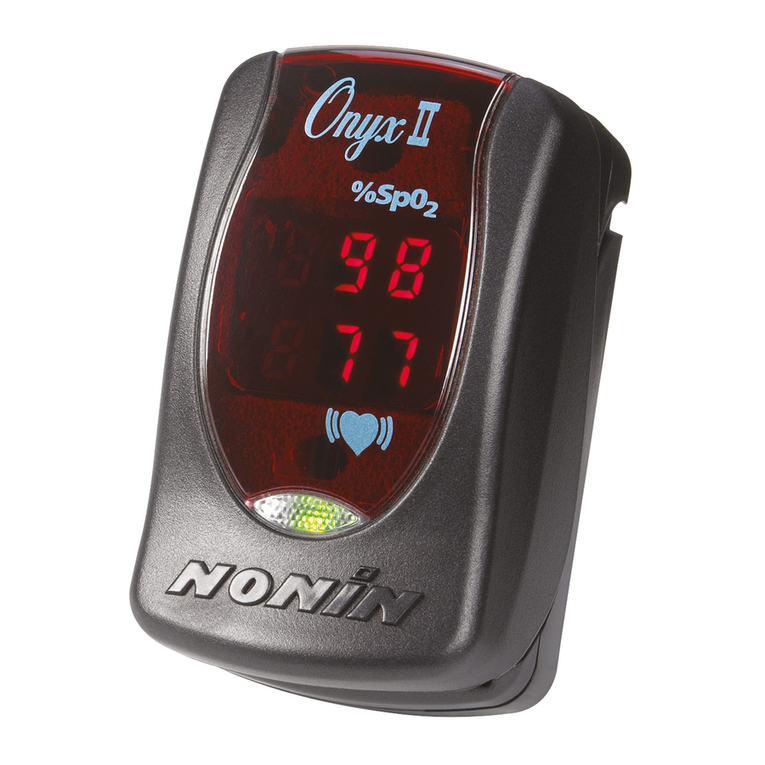
Nonin
Nonin Onyx II 9550 Manual

Nonin
Nonin 2120 User manual
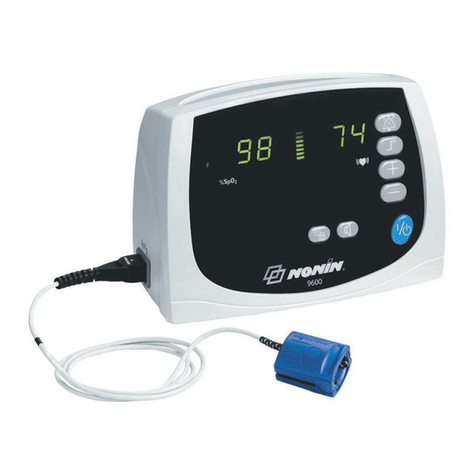
Nonin
Nonin Avant 9600 User manual
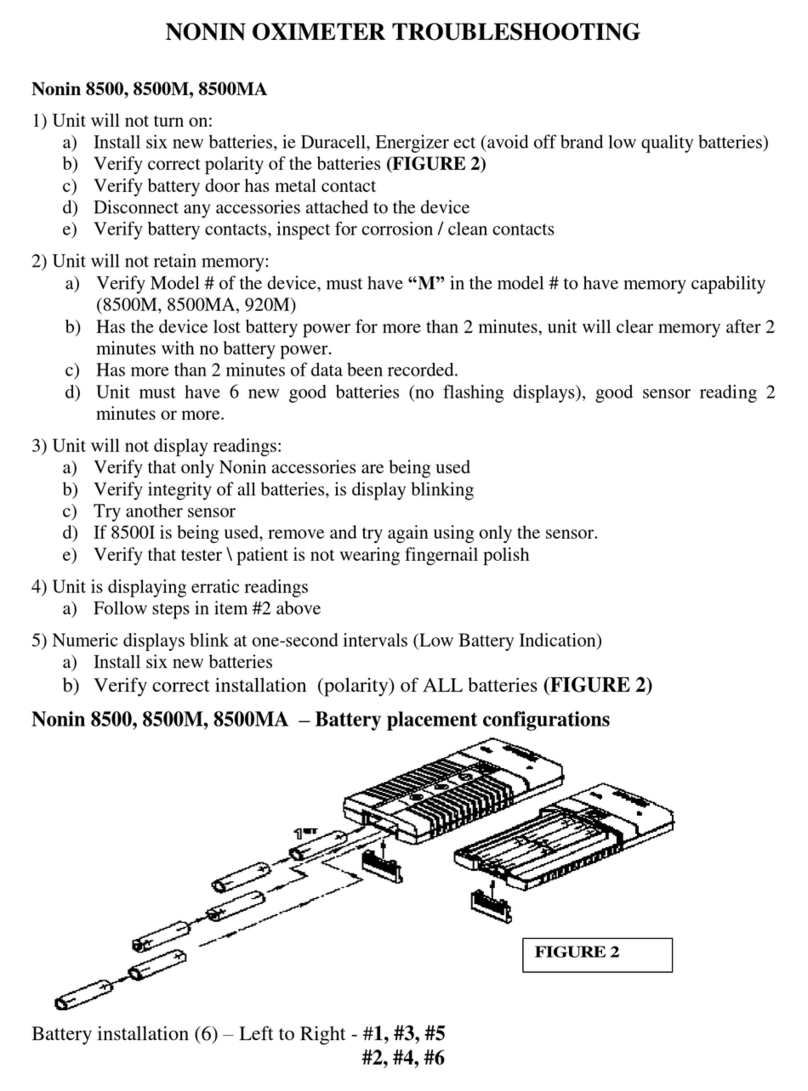
Nonin
Nonin 8500 Operating instructions
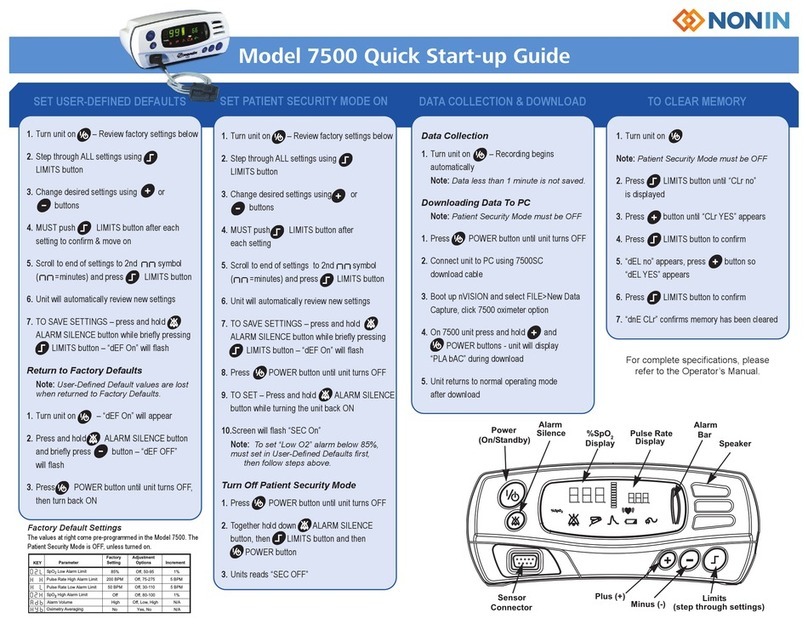
Nonin
Nonin 7500 Troubleshooting guide
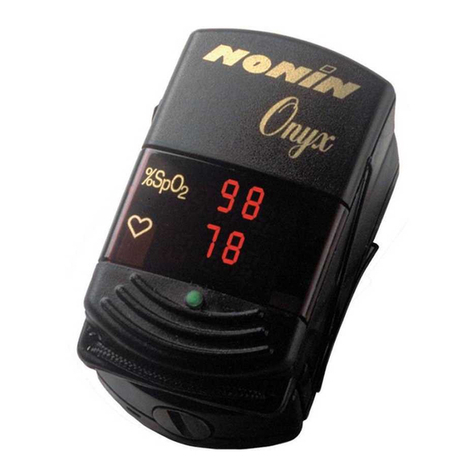
Nonin
Nonin Onyx 9500 User manual
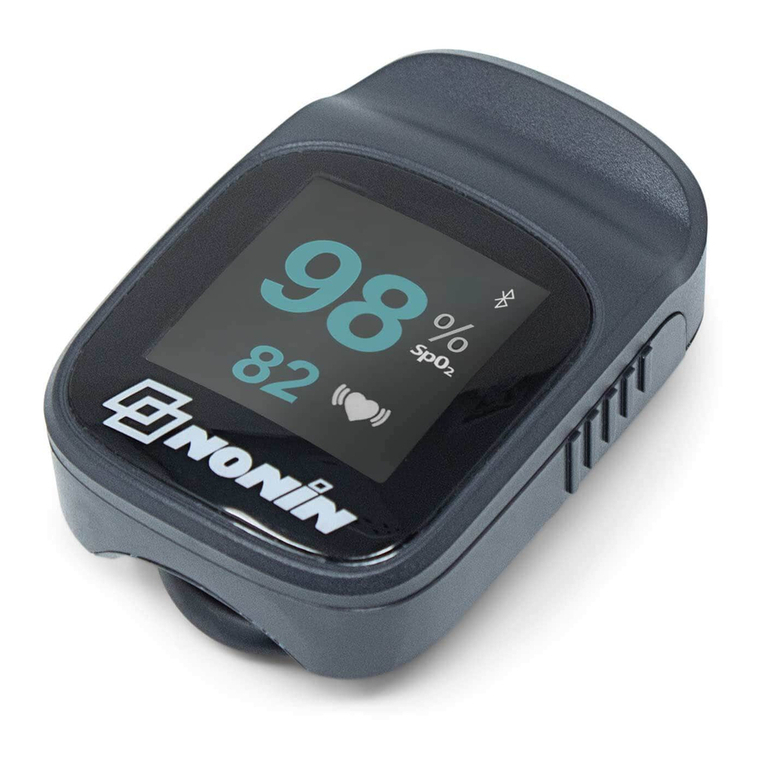
Nonin
Nonin NoninConnect Elite 3240 User manual
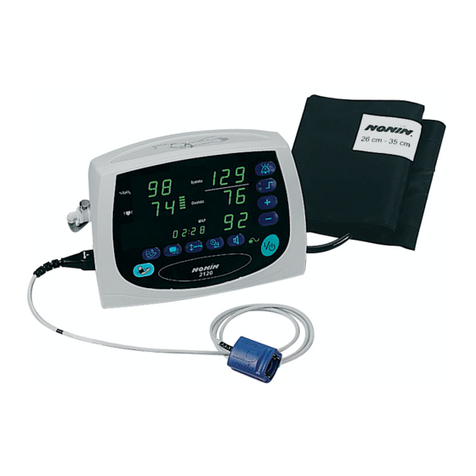
Nonin
Nonin 2120 User manual

Nonin
Nonin Onyx II 9550 Manual
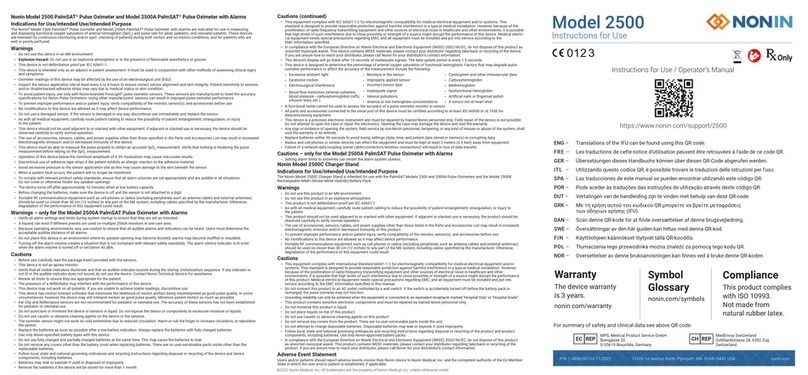
Nonin
Nonin 2500 PalmSAT User manual

Nonin
Nonin 8600V User manual
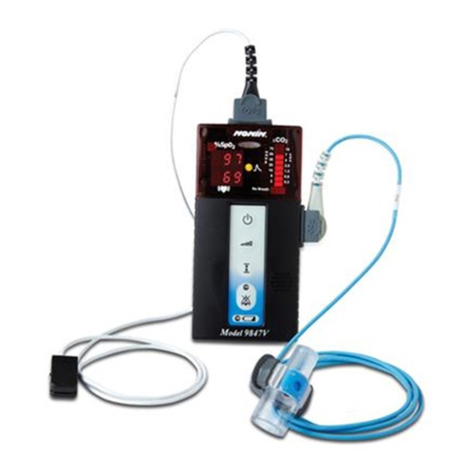
Nonin
Nonin 9847 User manual

Nonin
Nonin Onyx II 9550 User manual
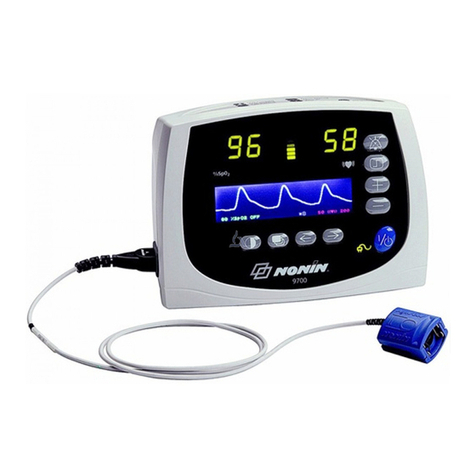
Nonin
Nonin Avant 9700 User manual

Nonin
Nonin Avant 4000 User manual
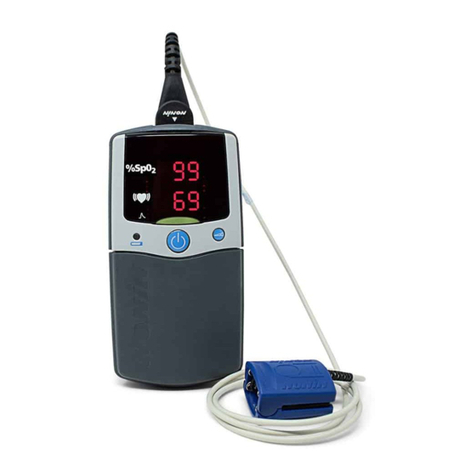
Nonin
Nonin 2500 PalmSAT User manual
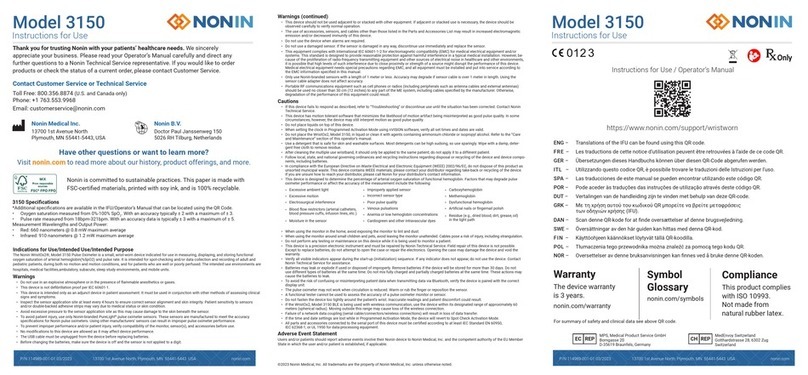
Nonin
Nonin 3150 User manual

Nonin
Nonin 7500 User manual
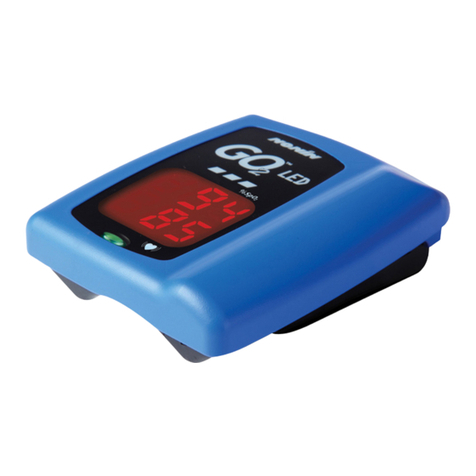
Nonin
Nonin GO2 LED Achieve User manual
